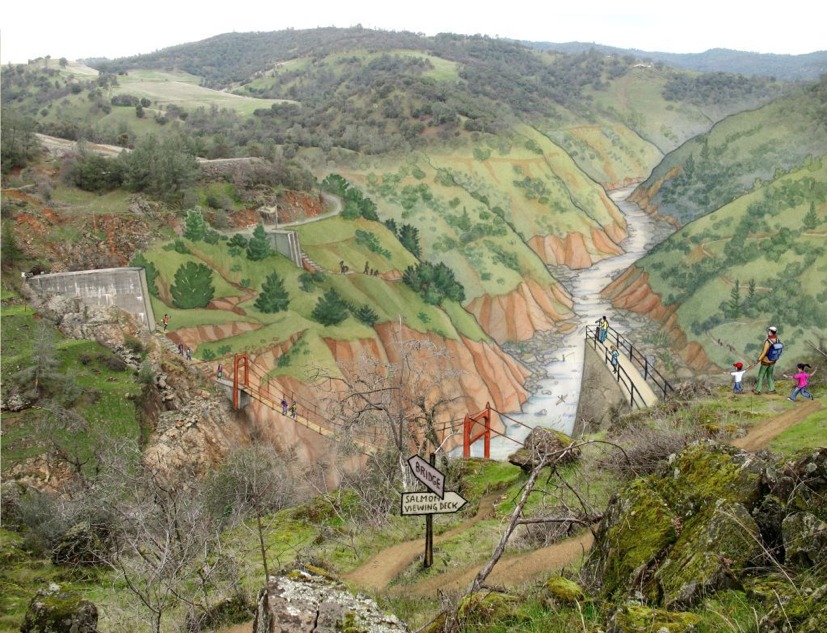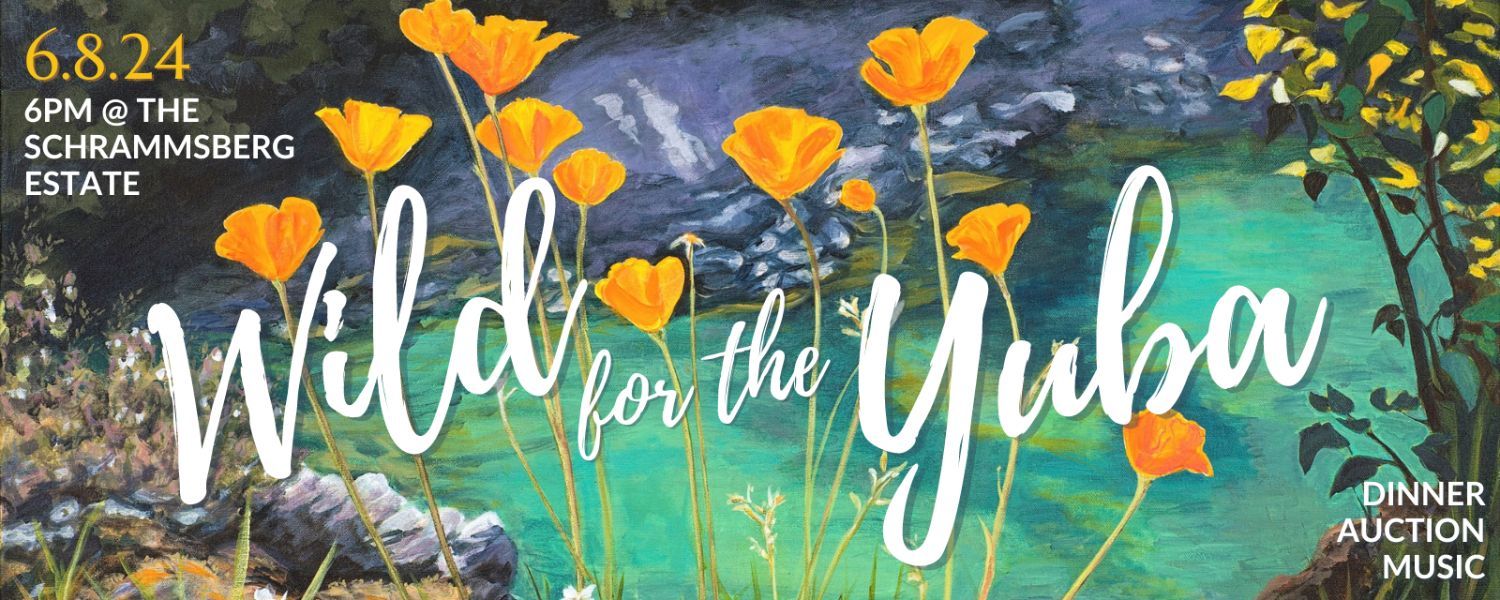Yuba Salmon Now! Strategy
Yuba Salmon Now!
A Solution to California’s Wild Salmon Crisis
A Campaign Strategy and Proposal for Restoring
Wild Salmon and Steelhead to the Upper Yuba River.
Offered by the South Yuba River Citizens League (SYRCL) and American Rivers

“Historic” Englebright Dam Site and Salmon Viewing Platform, Mainstem Yuba River.
Artists Concept by Mona Caron
California’s Salmon Crisis: What’s at Stake?
In the Pacific Rim, all waterways lead to Salmon. “Coastal” Californians, including those in the Sierra Nevada foothills, are indeed living in Watersheds Built By Salmon, both in an ecological sense spanning hundreds of thousands of years and in a cultural sense with the arrival of humans many millennia ago.
Of all the great salmon rivers of the world, the pre-1849 Sacramento River runs of Chinook salmon were among the mightiest, with estimates of 1-2 million salmon returning to their natal streams to spawn. The collapse of Central Valley Chinook in this first decade of the 21st century (from estimates of 800,000 returning spawners as recently as 2002 to 39,500 in 2009) is a result of multiple and interacting impacts to the ecological health of our freshwater, estuarine and marine environments.
Regardless of where and to what degree blame is ascribed to these causes (e.g. “ocean conditions,” pumping from the Delta, loss of functional floodplains, pollution from municipal and agricultural discharges, degraded riparian habitat, dams, etc.), the prospect of salmon extirpation within the greater San Francisco Bay-Sierra Nevada Watershed is an ecological crisis with severe implications to the biotic integrity of California.
Today Californians face a choice: Will we become forever exiled from the great “Salmon Nation” of the Pacific Rim, or will we take bold and immediate actions to reconnect our Central Valley rivers with the ancestral upland habitats that can provide refuge and habitat resiliency in a changing climate?
The magnitude of the problem warrants bold recovery measures—and rigorous public debate—that go well beyond the compromises that are typically reached through protracted negotiations that attempt to accommodate a broad range of “interests.” Such decision-making processes have brought our most ecologically beneficial, culturally important, and economically valuable species to the edge of extinction.
Due to a confluence of regulatory processes, legal actions, and the opportunities created through the wild salmon crisis itself, action or in-action on the Yuba River in the next 5 years will help determine the fate of wild salmon and dictate a course for California’s ecological future.
This Yuba Salmon Now! campaign strategy is designed to re-frame the salmon crisis in terms of this imperative for California.
Summary of Campaign Strategy
SYRCL, American Rivers and our allies are developing a 5-year strategy to affect key decisions that are to be made between now and 2016. This proposal is for the first 18-month phase of a broad-based and comprehensive campaign spearheaded by potent combination of a uniquely successful grassroots watershed organization (SYRCL) and the leading national river protection organization with expanding capacities in California (American Rivers).
The proposed campaign leverages our network of partners, our unique abilities for grassroots mobilization, our deep history with the politics and science of Yuba Salmon, and our relationships with decision-makers inside the beltway.
While cognizant of, and coordinated with, salmon advocacy efforts playing out in the Delta, the oceans and the “mainstem” rivers of the San Joaquin and Sacramento, the Yuba Salmon Now! campaign strategy is focused on the impacts to salmon from dams and is aimed squarely at the action of reintroducing salmon above the “terminal rim dams” (TRDs) and re-operating water supply to accommodate salmon within the middle elevations of the Sierra Nevada.
While SYRCL and American Rivers continue to provide leadership in advancing the science and regulatory processes of salmon recovery, our experiences and perspective make clear that the limiting factor to successful restoration of wild salmon in California is a coordinated and broad-based grassroots organizing effort to advance policy-level reforms for salmon management.
This proposal identifies the points of greatest leverage to meet our Campaign Goal, directs each organization’s greatest strengths to meet the Objectives, and identifies gaps in capacity to ensure a comprehensive and robust approach to implementing the strategy and tactics.
Campaign Goal:
To re-establish viable, self-sustaining populations of salmon and steelhead into the upper Yuba River, thereby doubling the population of threatened salmon species in the Central Valley.
Campaign Objectives:
Fish Passage: Restore salmon and steelhead to historic waters above Englebright, New Bullards Bar and Our House dams through volitional passage.
Cold Water Management: Provide sufficient in-stream flows to support salmon and steelhead in reaches of the Middle and South Yuba Rivers through new license operating terms for YCWA’s, PG&E’s and NID’s dams.
Qualifications of Campaign Proponents:
A Local and National Approach is Central to a Successful Strategy
Together, SYRCL and American Rivers are rooted in decades of experience in grassroots organizing, broad-based coalition building, application of the current science on fisheries and ecosystem management, and river policy reform through political, legislative and regulatory means.
SYRCL is uniquely positioned and wholly dedicated to organizing a watershed movement to ensure that California’s salmon heritage is preserved, beginning with the restoration of the uniquely wild salmon of the Yuba River Watershed.
For much of our 27 years, SYRCL has spearheaded a multi-faceted approach to protecting and restoring Yuba Salmon. We work with a diverse coalition of partnering organizations to lend our localized expertise and broad grassroots support to broader salmon recovery efforts in the ocean, in the SF Bay/Delta, and in river habitats from the Yuba’s headwaters and through the Feather River (See Table 1).
Table 1: SYRCL’s History of Partnership and Accomplishments for Yuba Salmon.
| 1989 | Entered litigation against YCWA to contest erratic river flows that harmed salmon. |
| 1999 | Secured initial funding for fish passage feasibility at Englebright Dam. Resulted in state and federal engagement leading to 9-year and $9M Upper Yuba River Studies Program. (Results of studies characterized sediment removal options behind dam and concluded sufficient habitat upstream of Englebright to support robust populations of spring-run Chinook and Steelhead.) |
| 1999 | Compelled fish passage feasibility studies at Daguerre Point Dam |
| 2001 | Conceived of and received funding to implement ecologically beneficial flood management through the Yuba-Feather Workgroup, which resulted in the implementation of floodplain restoration through precedent-setting levee setbacks (completed on the Bear River confluence (2006) and the 6-mile Feather River Levee Setback (2009), the largest levee setback in California). |
| 2005 | Concluded 16 years of litigation and negotiation in signing the Fisheries Agreement of the Lower Yuba River Accord, resulting in improved instream flows and $500K/year dedicated by YCWA toward salmonid research and habitat improvements. |
| 2005 | Co-founded the “Foothills Water Network” to build broad support from conservation organizations, anglers, whitewater boaters and tribes to support salmon re-introduction into the Upper Yuba through the FERC re-licensing process. |
| 2006 | Initiated lawsuit against NMFS and USACE to compel federal agencies to complete unfinished fish passage alternatives studies at Daguerre and Englebright by date certain. |
| 2006 | Joined the Steering Committee of the California Hydropower Reform Coalition, attracting support from statewide and national river protection organizations to bring expertise into the Yuba Basin hydropower relicensings. |
| 2006 | Co-founded with the Tsi-Akim Maidu Tribe the Calling Back the Salmon Committee, which annually brings hundreds of supporters to participate in a Maidu salmon ceremony (and political action of carrying the salmon around the dam) on the Yuba River. |
| 2006 | SYRCL, as a new member of the national Corps Reform Network, advocated for federal policy reforms for the US Army Corps of Engineers, enacted in Water Resources Development Act of 2007. |
| 2007 | SYRCL’s River Scientist begins serving as the only NGO representative on the River Management Team of the Lower Yuba River, which oversees a $500K budget directed at studies and actions to restore salmon habitat on the lower Yuba River. |
| 2007 | SYRCL hosts a “Yuba Salmon Townhall Forum,” attended by over 100 community members. Presentations by SYRCL and American Rivers staff and Maidu tribal leaders establish the scientific and moral case for re-introducing salmon to the upper Yuba. |
| 2007 | SYRCL organizes the “Source to Sea Collective,” engaging San Francisco-based artists, musicians and salmon advocates in 2-day symposium of movement-building through films and performance. |
| 2008 | SYRCL and Western Aggregates, LLC (the largest gravel mining company on the lower Yuba River) hold press conference announcing an Agreement in Principle for “Lower Yuba Rehabilitation Project” to move 4 river miles of land into a conservation easement with ambitious plan for physical habitat restoration in support of juvenile salmonids. |
| 2008 | SYRCL and the Salmonid Restoration Federation host “Spring-Run Chinook Symposium” in Nevada City, with 3-days of seminars, workshops and field tours highlighting the threatened Spring-run Chinook of the Yuba to a state-wide audience. |
| 2008 | SYRCL joins SalmonAid, a coalition organized by commercial salmon fisherman in response to the salmon collapse and the need for federal engagement in recovering California’s salmon industry. After 2 years participating in Bay Area outreach events, SYRCL joins SalmonAid Board of Directors in 2010. |
| 2009 | Initial $200K secured from public and private sources for preliminary studies for the “Lower Yuba Rehabilitation Project,” restoration design concepts completed June 2010. |
As our track record suggests, SYRCL has extensive and unique experience in all scientific and collaborative processes affecting Yuba Salmon over the past decade.
American Rivers is the leading conservation organization standing up for healthy rivers so communities can thrive. American Rivers protects and restores America’s rivers for the benefit of people, wildlife, and nature. Founded in 1973, American Rivers has more than 65,000 members and supporters, with offices in Washington, DC and nationwide. American Rivers has led dam removal, hydropower reform and salmon recovery efforts throughout the Western US.
Through our work in five key program areas – Rivers and Global Warming, River Restoration, River Protection, Clean Water and Water Supply – American Rivers is working to protect our remaining natural heritage, undo the damage of the past and create a healthy future for our rivers and future generations.
Did you enjoy this post?
Get new SYRCL articles delivered to your inbox by subscribing to our ENews.



Interested citizen. Please keep me informed.
I see a lot of interesting posts on your website. You have to spend a lot of time writing, i know how to save you a lot of time, there is a
tool that creates unique, SEO friendly articles in couple of seconds, just search
in google – k2 unlimited content